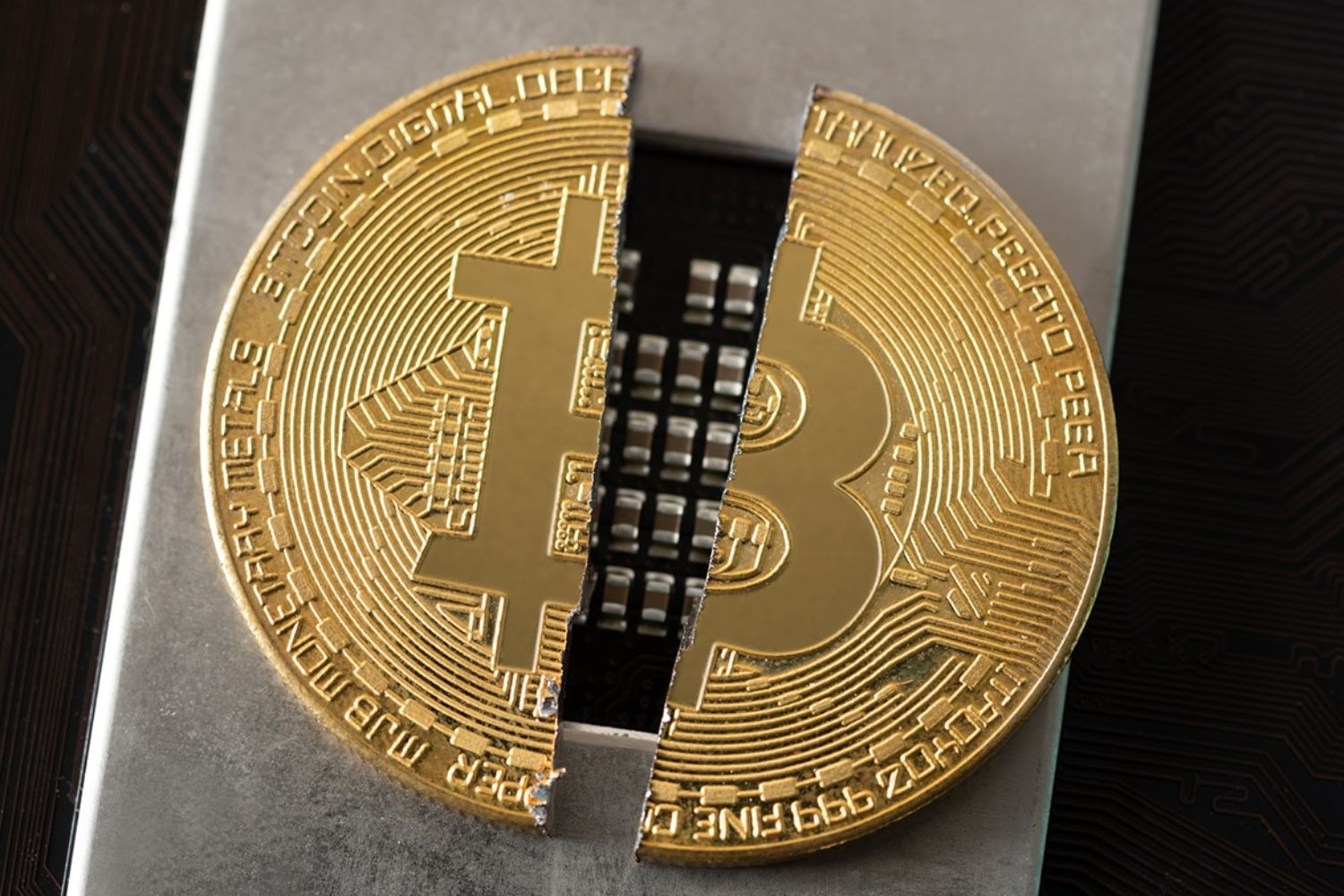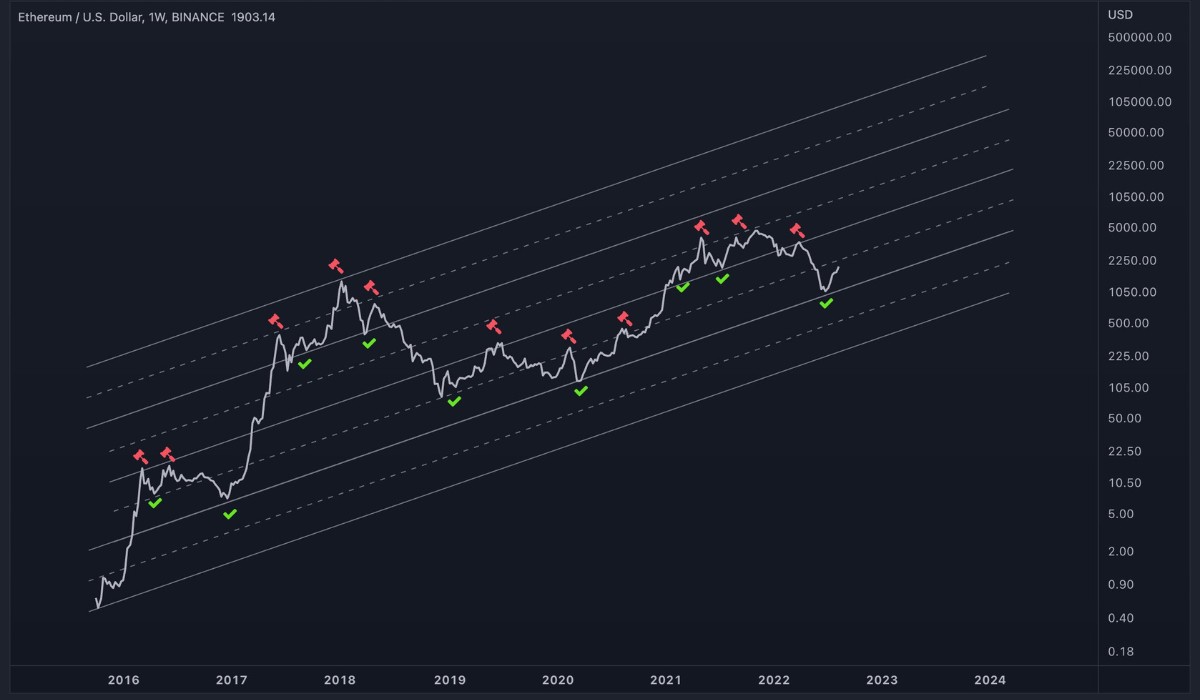Introduction
Welcome to the world of Bitcoin halving, a significant event in the cryptocurrency space that has been capturing the attention of investors, miners, and enthusiasts alike. If you’re new to the concept or looking to gain a better understanding of how it works, you’ve come to the right place.
Bitcoin, the first decentralized digital currency, was created in 2009 by an anonymous person or group of people using the pseudonym Satoshi Nakamoto. It introduced a revolutionary system that operates without the need for a central authority or financial intermediary. Instead, transactions are validated by a decentralized network of computers called miners.
Halving, or more commonly known as “halvening,” is an integral part of Bitcoin’s design. It is a pre-programmed event that takes place approximately every four years or after the completion of every 210,000 blocks. During this event, the rewards given to Bitcoin miners for verifying transactions are reduced by half.
Bitcoin halving serves as a mechanism to control the inflation rate of the cryptocurrency. By reducing the mining rewards over time, the supply of new Bitcoins entering circulation slows down, leading to a more scarce and valuable asset.
One of the main reasons for implementing halving is to mimic the scarcity of precious metals like gold. Just as gold becomes harder to mine as more is extracted from the ground, Bitcoin becomes harder to mine as the rewards diminish. This artificial scarcity is a fundamental feature that drives the value proposition of Bitcoin as a store of value.
Bitcoin halving events have garnered significant attention due to their potential impact on various aspects of the cryptocurrency ecosystem. It affects miners’ profitability, mining difficulty, transaction fees, and ultimately, the overall supply and demand dynamics of Bitcoin.
In this article, we will delve deeper into the mechanics of Bitcoin halving, its historical significance, the potential consequences, and the factors to consider during these events. By gaining a comprehensive understanding of this process, you will be better equipped to navigate the exciting world of Bitcoin and make informed investment decisions.
What is Bitcoin Halving?
Bitcoin halving is a predetermined event that occurs in the Bitcoin blockchain approximately every four years. It is a mechanism designed to reduce the rewards that Bitcoin miners receive for verifying transactions and adding them to the blockchain. The process involves cutting the block reward in half, hence the term “halving.”
When Bitcoin was initially created, the block reward was set at 50 Bitcoins per block. However, as part of its deflationary monetary policy, this reward is halved every 210,000 blocks. So far, there have been three halving events, resulting in block rewards of 25, 12.5, and currently 6.25 Bitcoins.
The purpose of Bitcoin halving is two-fold. Firstly, it helps control the supply of new Bitcoins entering circulation. By periodically reducing the block reward, the rate at which new Bitcoins are created slows down. This scarcity contributes to the finite nature of Bitcoin, making it more valuable over time.
Secondly, Bitcoin halving serves as a way to maintain a predictable inflation rate. Unlike traditional fiat currencies, where central banks can adjust the money supply at will, Bitcoin’s monetary policy is fixed and transparent. With every halving, the rate at which new Bitcoins are created reduces, ensuring a controlled and gradually decreasing inflation rate.
Bitcoin halving is hardcoded into the cryptocurrency’s protocol and is automatically triggered when a specific number of blocks are mined. The event is widely anticipated by the crypto community and often generates significant hype and speculation leading up to it.
It’s important to note that halving not only affects miners but also has implications for other participants in the Bitcoin ecosystem. The reduced block rewards could potentially impact miner profitability, leading to changes in mining activity and hashrate distribution. In turn, this may influence transaction processing speeds and fees.
Overall, Bitcoin halving is a critical event that plays a vital role in the long-term sustainability and value proposition of the cryptocurrency. It ensures the controlled release of new Bitcoins, reinforcing scarcity, and reinforcing its digital store of value status. Understanding the significance and mechanics of halving is essential for anyone involved in Bitcoin, whether as an investor, miner, or enthusiast.
The Purpose of Bitcoin Halving
Bitcoin halving serves several crucial purposes within the cryptocurrency ecosystem. Let’s explore some of the key reasons behind the implementation of this unique event.
1. Scarcity and Value: One of the primary purposes of Bitcoin halving is to establish and maintain scarcity. By reducing the block rewards over time, the rate at which new Bitcoins are introduced into circulation slows down. This scarcity increases the perceived value of each Bitcoin, as there is a limited supply available. Similar to precious metals like gold, the controlled reduction in block rewards supports Bitcoin’s store of value narrative and contributes to its price appreciation over time.
2. Controlled Inflation Rate: Bitcoin’s monetary policy is designed to have a predictable and transparent inflation rate. The regular halving events ensure that the rate of new Bitcoin creation decreases gradually. This controlled inflation rate is in stark contrast to traditional currencies backed by central governments, where inflation can fluctuate significantly based on policy decisions. Bitcoin’s fixed and deflationary supply model provides assurance to investors and users that the value of their holdings is not subject to arbitrary inflation.
3. Network Security: Bitcoin operates on a proof-of-work consensus mechanism, where miners dedicate computational power to secure the network and validate transactions. By reducing the block rewards through halving, Bitcoin incentivizes miners to continue contributing their resources even as the mining process becomes more challenging. This ensures that sufficient computational power is maintained to secure the network, protecting it from potential malicious attacks.
4. Longevity and Sustainability: By gradually reducing the block rewards, Bitcoin halving helps extend the lifespan of the cryptocurrency. As the rewards diminish, miners need to find efficiencies in their operations to maintain profitability. This encourages technological advancements and innovation in the mining industry, leading to increased efficiency and sustainability. The ability to adapt and optimize mining strategies is crucial for the long-term viability of the Bitcoin network.
5. Economic Incentives: The reduction in block rewards through halving affects the economic incentives of miners. It encourages miners to prioritize transaction fees as a significant portion of their revenue stream. As the block rewards decrease, transaction fees become a more substantial component of mining income. This incentivizes users to include appropriate fees when conducting Bitcoin transactions, creating a market-driven fee structure that helps ensure the timely processing of transactions and maintains the overall efficiency of the Bitcoin network.
Overall, Bitcoin halving serves as a fundamental mechanism that supports the underlying principles and value proposition of the cryptocurrency. It fosters scarcity, controls inflation, enhances network security, promotes sustainability, and aligns economic incentives. Understanding the purpose of Bitcoin halving is essential for investors and participants to appreciate its significance and potential impact on the cryptocurrency ecosystem.
How Does Bitcoin Halving Work?
Bitcoin halving is a pre-programmed event built into the code of the cryptocurrency that automatically adjusts the block rewards given to miners. Let’s take a closer look at how this process works:
1. Block Rewards: In the Bitcoin network, blocks are created approximately every 10 minutes, containing a collection of verified transactions. Miners compete to solve complex mathematical problems using computational power, and the first miner to solve the problem successfully adds the block to the blockchain and receives a reward. Originally set at 50 Bitcoins per block, this reward is halved approximately every four years.
2. Halving Schedule: Bitcoin halving occurs after every 210,000 blocks are added to the blockchain. With an average block creation time of 10 minutes, this translates roughly to a halving event every four years. So far, there have been three halvings, reducing the block rewards to 25, 12.5, and currently 6.25 Bitcoins per block.
3. Network Consensus: Bitcoin halving is determined by a consensus mechanism called “proof-of-work.” When a sufficient number of miners agree that a certain block has been successfully added to the blockchain, the network reaches consensus, and the block reward is adjusted accordingly. This decentralized consensus mechanism ensures that the halving events and their associated changes to block rewards are upheld by the majority of participants in the network.
4. Impact on Miners: Bitcoin mining is a competitive process in which miners invest significant computational power and resources to solve complex mathematical puzzles. The block rewards serve as an incentive for miners to continue participating in the network. When a halving event occurs, the block reward is reduced by half, directly affecting miner profitability. Miners must adapt to the reduced rewards by optimizing their operations, managing costs, and potentially relying on transaction fees as a larger portion of their revenue.
5. Market Response: Bitcoin halving events often generate significant market interest and speculation. As the supply of new Bitcoins entering the market decreases, the reduced selling pressure on miners may potentially drive up the price of Bitcoin. This anticipation of scarcity and potential price appreciation leading up to halving events has historically influenced market dynamics and attracted increased attention from investors and traders.
6. Block Validation: The process of validating and adding blocks to the blockchain remains unchanged during halving events. Miners continue to compete for block rewards by solving mathematical puzzles through the proof-of-work mechanism. The only difference is that the rewards for successfully adding a block are reduced after each halving event.
Bitcoin halving is a crucial component of the cryptocurrency’s design, contributing to its scarcity, controlled inflation rate, and long-term sustainability. By systematically reducing block rewards, Bitcoin halving ensures the gradual release of new Bitcoins and helps maintain a balance between miner incentives and network security.
History of Bitcoin Halvings
The history of Bitcoin halvings is a fascinating journey that showcases the evolution of the cryptocurrency and its impact on the market. Let’s delve into the three halving events that have taken place so far:
1. First Halving – November 28, 2012: The inaugural Bitcoin halving occurred approximately three years after the cryptocurrency’s creation. At the time, the block reward was reduced from 50 to 25 Bitcoins per block. This event marked an important milestone for Bitcoin, as it demonstrated the successful implementation of halving and its impact on the mining ecosystem. Following the first halving, Bitcoin experienced significant price appreciation, with the market valuing the cryptocurrency as a scarce and valuable asset.
2. Second Halving – July 9, 2016: Bitcoin’s second halving event took place approximately four years after the first. The block reward was again halved, this time from 25 to 12.5 Bitcoins per block. The 2016 halving occurred during a period of increased mainstream awareness and adoption of Bitcoin. The event generated substantial media attention and speculation, with many eagerly anticipating the impact on the price. Following the second halving, Bitcoin entered a prolonged bull market, reaching new all-time highs in the subsequent years.
3. Third Halving – May 11, 2020: The most recent halving event occurred in 2020, amidst heightened interest and growing adoption of cryptocurrencies. This event saw the block reward reduced from 12.5 to 6.25 Bitcoins per block. The 2020 halving was particularly significant as it took place during global economic uncertainty caused by the COVID-19 pandemic. Despite the challenging circumstances, Bitcoin’s third halving garnered enormous attention and drove increased interest from institutional investors. In the months that followed, Bitcoin experienced a remarkable price rally, breaking previous records and capturing the attention of mainstream financial markets.
The halving events of Bitcoin have consistently demonstrated the cryptocurrency’s unique supply and demand dynamics. By implementing a predictable reduction in block rewards, Bitcoin halvings contribute to the scarcity narrative and create an environment conducive to long-term price appreciation.
Each halving event has showcased the growing maturity of the cryptocurrency industry, with increased awareness, media coverage, and investor participation. As the number of Bitcoins entering circulation decreases, the market responds with heightened speculation and potential price volatility.
Looking ahead, the next Bitcoin halving is expected to take place around 2024. It will further reduce the block reward, reinforcing the scarcity of Bitcoin and potentially driving new cycles of price appreciation and market enthusiasm.
The history of Bitcoin halvings illustrates the unique and innovative nature of the cryptocurrency. These events, combined with other factors, have played a significant role in shaping the market dynamics and highlighting Bitcoin’s potential as a global store of value and medium of exchange.
Impact of Bitcoin Halving
Bitcoin halving events have a significant impact on various aspects of the cryptocurrency ecosystem. Let’s explore some of the key areas that are influenced by these halving events:
1. Miner Profitability: One of the immediate effects of Bitcoin halving is the reduction in miner profitability. As the block rewards are halved, miners receive fewer Bitcoins for their mining efforts. This puts pressure on miners to adjust their operational costs and optimize their mining efficiency to maintain profitability. Some miners with higher production costs may be forced to exit the market, while others may adopt more energy-efficient technologies to continue their mining operations.
2. Mining Network Hashrate: Bitcoin halving events have the potential to impact the overall hashrate of the mining network. As miner profitability decreases, some miners may choose to switch to more profitable cryptocurrencies or cease their mining activities altogether. This can lead to a temporary decline in the hashrate, as miners adjust their operations based on the new block rewards. However, over time, the mining network typically stabilizes as miners with more efficient operations enter the market.
3. Transaction Fees: With the reduction in block rewards during halving events, the importance of transaction fees within the Bitcoin network increases. Miners rely on transaction fees as an additional source of income to compensate for the lower block rewards. As the block rewards decrease, users may need to pay higher transaction fees to ensure their transactions are prioritized by miners. This change incentivizes users to include sufficient fees, leading to a more market-driven fee structure within the Bitcoin ecosystem.
4. Price Volatility: Bitcoin halving events often generate increased market speculation and can contribute to price volatility. The anticipation of reduced supply and the potential positive impact on market demand can drive price surges leading up to and following halving events. However, it’s important to note that the relationship between halving and price is complex, and other market factors also play a significant role in determining Bitcoin’s price movements.
5. Market Sentiment and Adoption: The media attention and public interest surrounding Bitcoin halving can have a profound impact on market sentiment and adoption. Halving events tend to attract new investors and increase mainstream awareness of Bitcoin and cryptocurrencies in general. This heightened interest can lead to increased adoption by individuals, institutions, and businesses, as they seek exposure to an asset that has a fixed supply and potential long-term value appreciation.
6. Long-Term Value Proposition: Bitcoin halving events are designed to reinforce the scarcity and store of value properties of the cryptocurrency. By reducing the rate at which new Bitcoins are created, halving events contribute to the long-term value proposition of Bitcoin. The controlled supply and increasing scarcity lend themselves to the narrative of digital gold, positioning Bitcoin as a potential hedge against inflation and an alternative store of wealth.
Bitcoin halving events are highly anticipated milestones in the cryptocurrency space, impacting miners, transaction fees, market sentiment, and the cryptocurrency’s overall value proposition. Understanding the potential ramifications of halving events is crucial for participants in the Bitcoin ecosystem, as they navigate the dynamic landscape of the digital currency.
Factors to Consider During Bitcoin Halving
Bitcoin halving is an event that has significant implications for various participants in the cryptocurrency ecosystem. As investors, miners, and enthusiasts prepare for the next halving, there are several important factors to consider:
1. Miner Profitability: The reduction in block rewards can have a substantial impact on miner profitability. Miners must carefully evaluate their operational costs, including electricity, hardware, and maintenance expenses, to ensure they can continue mining profitably. Factors such as mining difficulty, energy efficiency, and competitive mining pools can significantly influence a miner’s ability to remain profitable after a halving event.
2. Transaction Processing Speed: Bitcoin halving events can potentially impact transaction processing speeds within the network. As block rewards decrease, miners may give priority to transactions with higher transaction fees, leading to potential delays for transactions with lower fees. Users should consider adjusting their fee rates during periods of increased demand to ensure their transactions are processed promptly.
3. Market Volatility: Historical data suggests that Bitcoin halving events can contribute to increased market volatility. Speculation and investor sentiment can drive price fluctuations, potentially leading to both opportunities and risks for traders. It is essential to carefully assess risk tolerance and adopt a long-term perspective while navigating the market during and after a halving event.
4. Adoption and Mainstream Interest: Halving events often garner significant media attention and attract new participants to the Bitcoin ecosystem. Increased adoption and mainstream interest can have long-term effects on price, liquidity, and market dynamics. Understanding the potential impact of growing interest and adoption is important for investors and enthusiasts alike.
5. Market Sentiment and Psychological Factors: Psychological factors play a crucial role in market behavior during halving events. FOMO (fear of missing out) and speculative buying can drive prices to new highs, while fear and uncertainty can result in panic selling. Monitoring market sentiment, managing emotions, and making informed decisions based on research and analysis are vital aspects to consider during a halving event.
6. Regulatory Environment: Despite Bitcoin operating in a decentralized manner, regulatory actions and policies can impact the cryptocurrency’s ecosystem. Changes in regulations or government policies related to cryptocurrencies and blockchain technology can create both challenges and opportunities during or after a halving event. Staying informed about regulatory developments can help investors navigate potential implications on their investments.
7. Technological Advancements: The mining landscape and technological advancements can significantly impact mining profitability and efficiency during halving events. Miners should consider advancements in hardware technology, energy efficiency, and mining software to optimize their operations and maintain a competitive edge. Staying up to date with technological developments can help miners adapt to the changing environment and improve chances of profitability.
Bitcoin halving events are complex events that impact various aspects of the cryptocurrency ecosystem. Considering factors such as miner profitability, transaction processing speed, market volatility, adoption, regulatory environment, sentiment, and technological advancements can help participants navigate the potential challenges and opportunities presented by halving events.
Pros and Cons of Bitcoin Halving
Bitcoin halving is an integral part of the cryptocurrency’s design, but like any other event, it has its advantages and disadvantages. Let’s explore some of the pros and cons associated with Bitcoin halving:
Pros:
1. Scarcity and Value Appreciation: Bitcoin halving reinforces the scarcity narrative of the cryptocurrency. By reducing the rate at which new Bitcoins enter circulation, halving enhances the perception of Bitcoin as a finite and valuable asset. This artificial scarcity can contribute to the long-term value appreciation and store of value properties of Bitcoin.
2. Controlled Inflation: Bitcoin halving ensures a predictable and controlled inflation rate for the cryptocurrency. The reduction in block rewards over time gradually decreases the rate of new Bitcoin creation. This fixed and transparent monetary policy provides stability and confidence in the long-term value proposition of Bitcoin, distinguishing it from fiat currencies subject to unpredictable inflation.
3. Mining Network Sustainability: Halving events encourage miners to adapt, innovate, and improve operational efficiency. The need to maintain profitability in the face of reduced block rewards drives technological advancements in hardware, energy efficiency, and mining techniques. This constant evolution strengthens the mining network and contributes to its long-term sustainability.
4. Economic Incentives: Bitcoin halving incentivizes miners to prioritize transaction fees as a significant portion of their revenue. As block rewards decrease, miners rely more on transaction fees, creating a market-driven fee structure. This encourages users to include appropriate fees for their transactions, ensuring timely processing and efficient operation of the Bitcoin network.
Cons:
1. Miner Profitability: Bitcoin halving entails a reduction in block rewards, which directly impacts miner profitability. The decrease in rewards can lead to higher mining costs in relation to income, making it less profitable for smaller-scale miners or those with higher operational expenses. This may result in some miners exiting the market, potentially centralizing the mining process.
2. Transaction Processing Speed: The shift in miner incentives during halving events can influence transaction processing speeds. Miners may prioritize transactions with higher fees, potentially causing slower confirmation times for transactions with lower fees. Users may need to adjust their fee rates during periods of increased demand to ensure their transactions are processed promptly.
3. Market Volatility: Halvings generate increased market speculation, which can contribute to price volatility. The anticipation of reduced supply and potential price appreciation can lead to price surges before and after halving events. While this volatility can present opportunities for traders, it also poses risks and challenges for investors navigating the market.
4. Energy Consumption: Bitcoin mining is energy-intensive, and as the mining network grows, energy consumption increases. Halving events may exacerbate energy consumption concerns, as miners strive to maintain profitability despite reduced block rewards. The environmental impact of Bitcoin mining and its energy consumption remains a topic of debate and scrutiny.
Understanding the pros and cons of Bitcoin halving is essential for participants in the cryptocurrency ecosystem. While halving events reinforce scarcity, controlled inflation, and network sustainability, they also pose challenges in terms of miner profitability, transaction speeds, market volatility, and energy consumption. Evaluating these factors can help individuals make informed decisions and navigate the dynamic landscape of Bitcoin.
The Future of Bitcoin Halving
The future of Bitcoin halving is an exciting and highly anticipated topic within the cryptocurrency community. As we look ahead, several key aspects can influence the trajectory and impact of future halving events:
1. Bitcoin Adoption: The increasing adoption of Bitcoin by individuals, businesses, and institutional investors can have a profound effect on future halving events. As more entities recognize the potential value of Bitcoin and seek exposure to the cryptocurrency, the demand-supply dynamics may further accentuate during halving events, potentially leading to increased price volatility and market interest.
2. Regulatory Developments: The regulatory environment surrounding cryptocurrencies continues to evolve. Future regulatory actions and policies can shape the landscape for Bitcoin halving events, potentially impacting market sentiment, participant behavior, and the viability of mining operations. It is crucial to monitor regulatory developments and consider their potential implications for future halving events.
3. Technological Advancements: The mining industry continually evolves through technological advancements. Future improvements in hardware efficiency, energy consumption, and mining techniques can enhance miner profitability and sustainability. Innovations like more energy-efficient mining equipment and advancements in proof-of-work consensus algorithms may shape the landscape of mining and the mining rewards associated with halving events.
4. Scaling and Network Capacity: Bitcoin’s scalability remains an ongoing challenge. As the network grows and transaction volume increases, scalability solutions such as the Lightning Network and further protocol upgrades may be necessary to accommodate the rising demand. The ability to scale effectively can play a role in the long-term viability of Bitcoin and the ecosystem during future halving events.
5. Economic Factors: Macroeconomic events and monetary policies can influence market sentiment and adoption of Bitcoin. Economic recessions, inflationary pressures, and geopolitical developments can drive interest towards Bitcoin as a potential hedge against traditional financial systems. Future halving events during such periods may be accompanied by increased attention and demand for Bitcoin as an asset.
6. Community Consensus: The Bitcoin community plays a significant role in determining the future direction of the cryptocurrency. The ability to reach a consensus on matters such as the block size, transaction fees, and scalability solutions will shape the ecosystem and determine how halving events are perceived and managed. Community cooperation is crucial in maintaining the stability and growth of Bitcoin.
As Bitcoin continues to mature and solidify its position as a global digital asset, future halving events will undoubtedly play a crucial role. They will reinforce Bitcoin’s scarcity and controlled inflation, incentivize technological innovation in mining, and impact market dynamics. The constant evolution of the cryptocurrency space ensures that future halving events will be met with anticipation, speculation, and continued interest from participants within the Bitcoin ecosystem.

























